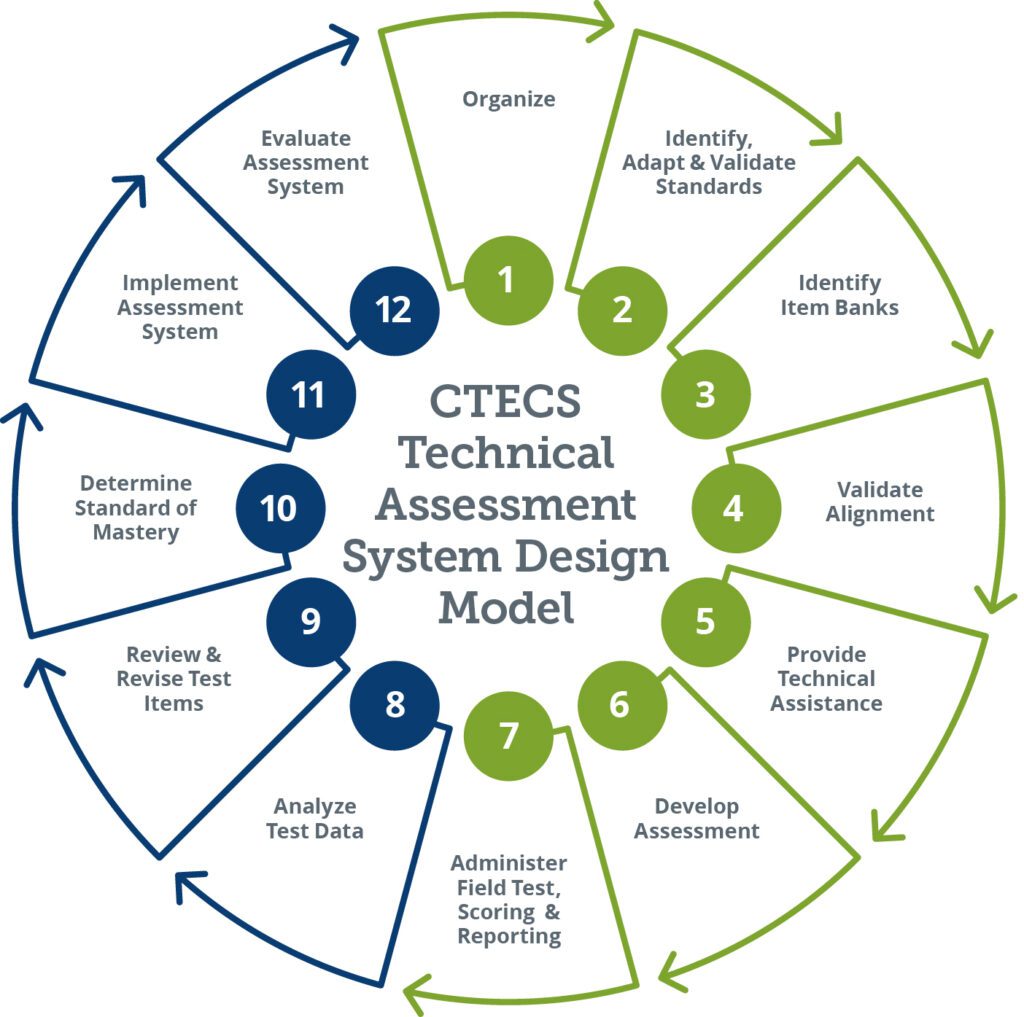Model

CTECS' Assessment Design Model
All by following its proven Assessment Design Model, CTECS can
- build course standards or competency lists
- analyze existing standards and competency lists
- create custom-built, program-specific tests
- establish pass/fail scores
- offer credentials for successful student completion
- collect all related data in formats easily adaptable to your needs.
Introduction
How We Do What We Do
The CTECS model for designing a technical assessment system involves following a step-by-step process that assures valid, defensible, psychometrically sound tests. It begins with the identification of a Business/Industry/ Education Technical Advisor Committee and ends with a fully operational, field tested system. CTECS believes that assessment tools must be aligned to a set of measurable standards or competencies and that items must meet rigorous quality guidelines. Each activity is conducted with these overriding criteria in mind. CTECS provides the level of service that works best for each client.
You can depend on our experience to:
- train your staff to design and develop your assessment system
- facilitate your staff's work as they design and develop the system, or
- develop the entire system for you.
No matter which level of service you choose, the result will be a practical, cost-effective solution to your assessment challenges.
While every assessment system is unique, the development will include the first seven steps in the model as described with five additional steps below.
.01
Initial Organizational Steps
Establish clear avenues of communication between CTECS and the client and identify the Business/Industry/Education Technical Advisory Committee (TAC)subject matter experts who will guide and approve each step of the process.
.02
Identify/Adapt/Develop/Validate a Skill Standards List
Identify existing skill/standards or competency lists from CTECS’ database and from the client’s resources. Research these resources to create a list that can be reviewed and validated by the TAC.
.03
Item Development and Modification
Develop an item bank blueprint and identify existing items from CTECS’ database and from the client’s resources. Review the identified items and develop additional items.
.04
Validation of the Items
Review all items for accuracy, relevance, and alignment with the standards. The TAC performs this activity and has final approval on all items.
.05
Provide Technical Assistance
Develop instructional manuals for the administration of the assessment instrument.
.06
Assessment Development
Develop an assessment blueprint based on the levels of criticality assigned to the standards during review and analysis.
.07
Field Test Administration, Scoring and Reporting
Publish the assessment(s) via a web-based system; score the test(s); report the results. Provide the customary item analysis data.
.08
Interpret the Test Results and Item Analysis
Establish guidelines for interpreting the statistical data collected from the administration of the test and the item analysis.
.09
Review/Revise Test Items
Review the test and individual items using the established guidelines. Make revisions determined appropriate by the review.
.10
Determine the Standard of Mastery (Cut-Off Score)
Select a procedure for establishing the standard of mastery (cut-off score), e.g., the Modified Angoff Method, to determine test takers who have met the criteria. Set the cut-off score.
.11
Implement the Assessment System
Finalize the test administration schedule; publish the assessment instrument(s) via a web-based system; score the tests; provide score reports to individuals and agencies.
.12
Evaluate the Assessment System
Review the assessment system and each step of the process. Refine the system based on the evaluation results. Document the entire process.
Click here for the CTECS Technical Assessment System Design Model as a PDF.
CUSTOMIZE THE MODEL TO FIT YOUR NEEDS
CTECS is anything but cookie-cutter. And don’t forget we pool pre-developed resources from our other member states to create manageable solutions for any situation.
